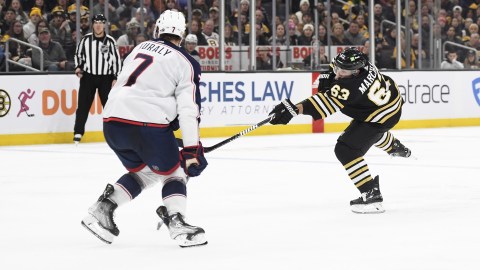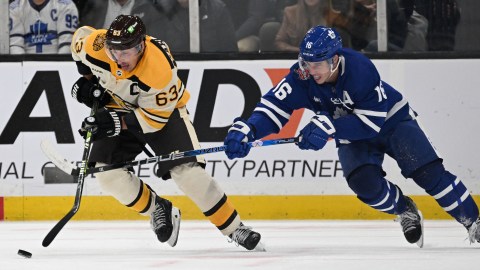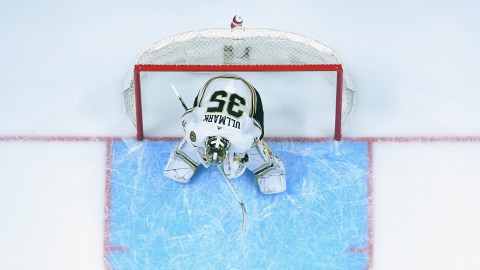With both the Bruins and the Lightning entering Saturday’s Eastern Conference final opener on a roll, it was difficult to predict what exactly was going to happen when the two teams finally clashed. But of all the possible outcomes, Bruins fans probably didn’t expect what actually happened.
Behind a number of uncharacteristic mistakes, the Bruins allowed three goals in a span of 85 seconds, which created a 3-0 hole that they were unable to climb out of.
Dwayne Roloson continued his stellar play in net for the Lightning, as the Bruins were unable to generate much offense in a 5-2 defeat, particularly on the power play.
Paul Kennedy, the Lightning rinkside reporter for FOXSportsFlorida.com, has been covering the Lightning every step of the way. He was nice enough to answer some questions about what happened in Game 1 and what we should expect from both teams in Game 2.
NESN.com: The Lightning had nine days off before Game 1, two more days than the Bruins, yet Boston looked much more rusty in the opener. What did Tampa Bay do to stay sharp between series, and do you think the long layoff had anything to do with the 5-2 final score?
Paul Kennedy: “Nine times, Mrs. Buehler. Nine times.” As Ferris’ high school principal, Mr. Rooney, so astutely could attest, nine days between games is a lot of vacation time.
Given that the NHL grind commences with training camp in September and continues through All-Star weekend — when 48 hours on a couch feels like a month on the beaches of Cancun — the breaks prior to the Eastern Conference final served both clubs well. Emotionally, as well as physically, the Bolts and the Bruins were equally refreshed and surprisingly sharp.
Lightning head coach Guy Boucher carved the calendar in this fashion: four days off and five days on the ice. Having earned a master’s degree in sports psychology, Boucher repeatedly held concise team meetings without on-ice skating as standard operating procedure over the second half of the season.
Just over a week ago, when enjoying a 3-0 lead against Washington, he again cancelled the morning skate in favor of a late afternoon chalk-talk prepping for the evening’s potential close-out affair. Locker room leaders and Stanley Cup veterans Martin St. Louis and Vincent Lecavalier strongly recommended Guy hold, at the very least, a 10 a.m. strategy session. Professional athletes are, after all, creatures of habit. Boucher listened, and later that night, the Lightning finished off the Caps.
The Lightning’s playoff theme, worn on shirts and displayed on locker room banners, is “Hunt It Now,” a reference to the team’s pursuit of the Cup. The accompanying song blaring from the room’s stereo speakers following each postseason win is straight from the 1970s, which has brought laughter and levity to the men in blue. It’s the Bee Gees’ disco classic “Stayin’ Alive.”
Through the first two rounds and now into this showdown in New England, they’re still dancing like John Travolta. Team bonding in the run up to Boston took the form of a bowling tournament, a barbecue and a few on-ice games — complete with teams and standings — rather than grinding through drills. The boys even played pingpong on the table that’s at the heart of the Bolts’ weight room.
Less was more.
And when the puck dropped Saturday night, both Tampa Bay and Boston maintained an intense, quickening pace through the first eight minutes of the emotionally charged series opener. The passing was respectably precise, there were few offsides whistles and there were few gaffes that resulted in a chance. That was, of course, until the Bolts’ 90-second, three-goal eruption.
NESN.com: The Bruins were 0-for-4 on the power play in Game 1 and now are 2-for-41 on the man advantage in 12 games this postseason. Do you think Tampa Bay can continue to prevent Boston from breaking out on the power play?
PK: For all of the focus on the Bolts’ tremendous skill and the Steven Stamkos–Sean Bergenheim-Vincent Lecavalier-Martin St.Louis power-play fireworks, it’s been the selflessness of the penalty kill that has lifted the Lightning to the conference final.
Tampa Bay’s penalty kill is dedicated to its architect, respected assistant Wayne Flemming, who is courageously battling brain cancer that was diagnosed just prior to the playoffs. He is a towering figure of inspiration to the Lightning’s veterans and playoff initiates alike.
GM of the Year nominee Steve Yzerman added the two cornerstone pieces of the penalty kill after the holidays. Starting goaltender, and Conn Smythe candidate, Dwayne Roloson and defenseman Eric Brewer have had a monumental impact on the NHL’s postseason. The rebounds are few, and Brewer is adept at clearing the puck away from attackers.
Before strategy, consider the numbers. Pittsburgh, in a seven-game series, scored one power-play goal. Washington, in its four-game swoon, tallied twice. Tampa Bay killed 51 of 54 man advantages against the Pens and Caps. Add a perfect 4-4 by a special teams unit that also features a decade of wisdom in defenseman Mattias Ohlund, on-the-rise blueliner Victor Hedman and gritty and skilled Ryan Malone — all alternating between conventional defensive boxes and diamond-formed pressure on the attackers’ points — the Bolts are now 55-for-58 when playing shorthanded. That’s an unheard of 94 percent success rate.
They block shots. “Rollie The Goalie” is stopping slappers. He’s made 397 playoff saves through Saturday. If he can see the puck, Roloson will stop it. Boston must get traffic to the net, but — as the Pens and Caps will testify — that’s been nearly impossible.
NESN.com: Patrice Bergeron may or may not play in Game 2. His absence in Game 1 was especially noticeable at the dot, as the Lightning won 61 percent of the faceoffs (41-for-67). What makes Tampa Bay so good on faceoffs, and will the Lightning play any different with Bergeron in the lineup?
PK: The Tampa Bay coaching staff is the first to point out that Patrice Bergeron’s absence played a significant role in Boston’s faceoff issues in Game 1. That he may return Tuesday is already a factor in preparing for the Garden encore.
Take a glance at the NHL stats for faceoff excellence this postseason. No man has won as many draws as Bergeron, who’s won 130 through 11 games. Yet, among the top 30 in Stanley Cup playoff action, there’s not another Bruin to be found.
Tampa Bay, conversely, finds strength on the draw, as Steven Stamkos, Dominic Moore and Vincent Lecavalier rank just behind Bergeron among those still alive in the cup quest. In Saturday’s Game 1, former Bruin Nate Thompson came up big on the dot, winning nine draws — second only to Lecavalier’s 16-for-26 showing.
The Lightning staff, driven by the players’ ambitions to improve, studies video of every opposing skater for tendencies and strengths. The only place in the NHL — and in life — that success comes before work is in the dictionary. Go around the locker room and the centermen taking draws will cite hours in front of monitors and at the rink drilling to improve.
The Bolts worked hard on faceoffs this Sunday at practice following the Game 1 win, and for good reason. While the Bruins’ David Krejci and Rich Peverley did their best to compensate for Patrice’s absence, they combined to drop 25 draws. The Lightning are convinced Krejci will be better as the series continues. He has a history of success against Tampa Bay on faceoffs.
On Saturday, Tampa Bay captured 41 of the 67 faceoffs and claimed puck possession time and time again. The Harvard educated and impressive Bolt checker Dominic Moore went 6-for-10, while Stamkos went 4-for-5.
Left-handed, right-handed, offensive zone, defensive zone or in the neutral zone, the Lightning have both depth and options, and place a high priority on succeeding at the dot.
NESN.com: The Lightning had only eight penalty minutes in Game 1 and played a near flawless game in terms of limiting mental mistakes. After the game, Tampa Bay coach Guy Boucher talked about the team’s ability to “reload emotionally” and stay calm under pressure. Have you seen the Lightning mature this season, and who are the Lightning’s leaders in the locker room that set the tone on the ice?
PK: When the postseason pushed away from the dock, nearly half of the Lightning’s crew had never sailed into playoff action — nine skaters in all.
The Penguins’ Brooks Orpik finished a hard check early in the opener against Steven Stamkos that was both inspirational for the Pens and educational for Stammer. “Welcome to the School of Hard Knocks,” he learned, and while Pittsburgh won three of the first four games in the series, they never sealed the deal. Boucher’s troops were fast learners.
Stamkos lockers shoulder-to-shoulder with St. Louis, and that’s not by coincidence. Marty is a master at maximizing intensity among his teammates, while insisting they all maintain the capacity to think.
St. Louis endured oral surgery on his two front teeth — compliments of an Orpik stick — and has still marched on, even though those same chompers were loosened again in round two. One cannot overstate what he means to the franchise. There is a growing realization that St.Louis is the greatest professional athlete the Bay area has seen, including the Super Bowl champion Bucs’ captain Derrick Brooks and his Hall of Fame predecessor, Lee Roy Selmon.
He could very well win the Hart Trophy for a second time this June and, remember, the perennial All-Star was never drafted. His protege, Stamkos, who was selected first overall just three summers ago, is a Lindsay finalist as the NHLPA’s MVP. The two clearly have so little, yet so much, in common.
NESN.com: The Lightning looked like the better team in Game 1, but as the Bruins have proven this postseason, they have a lot of resolve. Do the Lightning have any weaknesses that the Bruins could exploit in Game 2 and the rest of the series?
PK: Tampa Bay has now won eight consecutive playoff games, and the first three in the run were elimination games. The key throughout has been the Bolts’ ability to score first. Strategically and physiologically, they have held the upper hand, allowing their acclaimed 1-3-1 trap to maximize its effectiveness against foes playing from behind.
If Boston scores first in Game 2, it will be interesting to see if the B’s could defend that lead, backed by the home crowd. As witnessed in the opener, three “Lightning strikes” in 90 seconds sent Boston reeling. Tampa Bay counters so quickly and skillfully off turnovers that they produce multiple chances in a matter of seconds.
Awaiting Game 2 in Boston is a deservedly confident Lightning team, as measured in its collective conviction that the Boucher system works, the goaltending is of championship caliber, the defense is poised and experienced and the offensive firepower is among the league’s elite.
Against the pressure of Tampa Bay playing with the lead, Boston lost its poise and Game 1.
Thanks again to Paul Kennedy for answering our questions. Please check back before every game of the Bruins-Lightning series for more Across Enemy Lines. You also can read NESN.com Bruins reporter Douglas Flynn’s contributions to this feature on FOXSportsFlorida.com.



